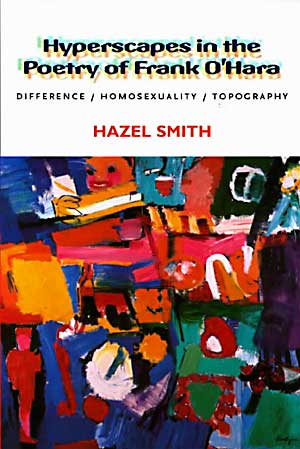
Hyper O’Hara |
 Terence Diggory reviews
|
|
Many fans of Frank O’Hara will be put on guard by Hazel Smith’s prefatory confession that she lost interest in O’Hara’s life early in the process of research that led to her book Hyperscapes in the Poetry of Frank O’Hara. Isn’t it O’Hara’s distinctive achievement precisely to make his life and his poetry seem inseparable? Don’t we admire O’Hara, above all, for the vividness of his voice? Smith admires the performance that creates this voice but she refuses to identify the performer with O’Hara. Rather, a ‘splintered subjectivity’ speaks in the poems (144), an array of ‘different types of recontextualised talk’ that compose a ‘talkscape’ (143). As ‘talkscape’ intertwines with ‘textscape,’ recontextualised literary language and patterning, the result is the complex weave that Smith calls the ‘hyperscape’ (151). |
and I have lost what is always and everywhere
Here are Smith’s comments on these lines in three separate chapters of her book: For the engimatic serpent who appears throughout the poem as phallic yet feminised, erect but coiled, single but also multiple, is a symbol of ultimate difference. In order to secure this difference it is necessary to kill ‘the scene of my selves’, that is, a fixed sexual identity, an absolute sense of place, and writing as closure. (chap. 2, p. 73)
Rather than exposing ‘diverse meanings,’ these passages all seem to be controlled by the single dominant concept that Smith identifies with postmodernism: the concept of ‘difference.’ Rather than ‘jostling together,’ these passages remain just as inert when placed next to each other as they appear when first encountered in isolation. Although she opposes fixity in concept, Smith produces fixity in practice by pinning down an image in O’Hara’s poem with a concept: ‘the scene of the selves’ = ‘the social construction of masculinity.’ Multiplying the number of concepts does not help to revive the image, because, once again, what appears to be several concepts reduces to one. The formula at the end of the first quotation simplifies to: ‘the scene of my selves’ = ‘fixity.’ At the very end of ‘In Memory of My Feelings’ O’Hara rises up in what looks like an heroic gesture aimed at striking through all the masks, penetrating to authenticity and pulling himself together at last. But the phrase ‘I myself and singly’ splits the self in the very act of unifying it and the final line declares O’Hara’s intent to ‘save’ that slippery, invasive, poisonous, beautiful energy that keeps proliferating new transparencies, selves, guises — the energy that allows O’Hara to work inside all these old fictions and disguises and make them live again. (Breslin 248)
If Smith’s key word is ‘difference,’ Breslin’s is ‘energy,’ but that word behaves not so much as a containing concept but as a syntactical vortex out of which new movement ‘keeps proliferating.’ The resulting series — ‘slippery, invasive, poisonous, beautiful’ or ‘transparencies, selves, guises’ — do not contain terms that substitute for each other, metaphorically, as tropes belonging to a single category. Rather, they slip away from each other in a potentially endless metonymic chain. Breslin’s prose performs ‘hypertextually’ much more successfully than Smith’s does. Even more important, Breslin’s criticism comes much closer to what it feels like to read O’Hara; it recognizes O’Hara’s text as a performance but responds, not with a theory, but with a parallel performance, located on another plane of the critical hyperscape. At an earlier point in his reading of ‘In Memory of My Feelings,’ Breslin explains his approach: Perhaps the best way to deal with this passage is not so much by trying to extract meaning from it — all too easy, as it turns out — but by trying to articulate the processes we follow as we read it. Our best position is thus a step away from it and from there we can see how reading the poem engages the reader with precisely those difficulties that the poet is writing ‘about.’ (Breslin 242–43)
Interestingly, the importance of energy emerges in Smith’s account when she deals with the spirit of improvisation in O’Hara. She evokes that spirit not as a theorised ‘difference’ but as the emotion of dizziness: ‘One of the effects of improvising in O’Hara’s poems is the dizzy effect of the poem exuberantly propelling itself forward’ (164), similar to the effect Breslin attempts to enact in his series. For Smith, the achievement of dizziness is an alternative to the more intellectual means of self-parody, also aimed at undoing the ‘self-regulation’ of the traditional subject. In response to O’Hara’s ‘Ode to Joy’ (1957), Smith writes, ‘This poem strikes at accepted values of self-control and self-regulation through Dionysian dizziness rather than logical argument’ (133). |
Additional ReferencesBreslin, James. From Modern to Contemporary: American Poetry, 1945-1965. Chicago: Univ. of Chicago Press, 1985.
Brossard, Olivier. ‘The Last Clean Shirt: A Film by Alfred Leslie and Frank O’Hara.’ Jacket 24 (November 2003). Nietzsche, Friedrich. The Birth of Tragedy and The Genealogy of Morals. Trans. Francis Golffing. Garden City, N.Y.: Doubleday-Anchor, 1956.
Smith, Hazel. ‘Returning the Angles.’ Jacket 7 (April 1999).
Smith, Hazel, and AustraLYSIS. ‘Intertwingling.’ How2 1.5 (March 2001).
Smith, Hazel, and Roger Dean. ‘The Egg The Cart The Horse The Chicken: Cyberwriting, Sound, Intermedia.’ IMEj 4.1 (April 2002).
———. Improvisation, Hypermedia and the Arts since 1945. London: Harwood Academic, 1997. |
|
Jacket 22 — May 2003
Contents page This material is copyright © Terence Diggory
and Jacket magazine 2003 |